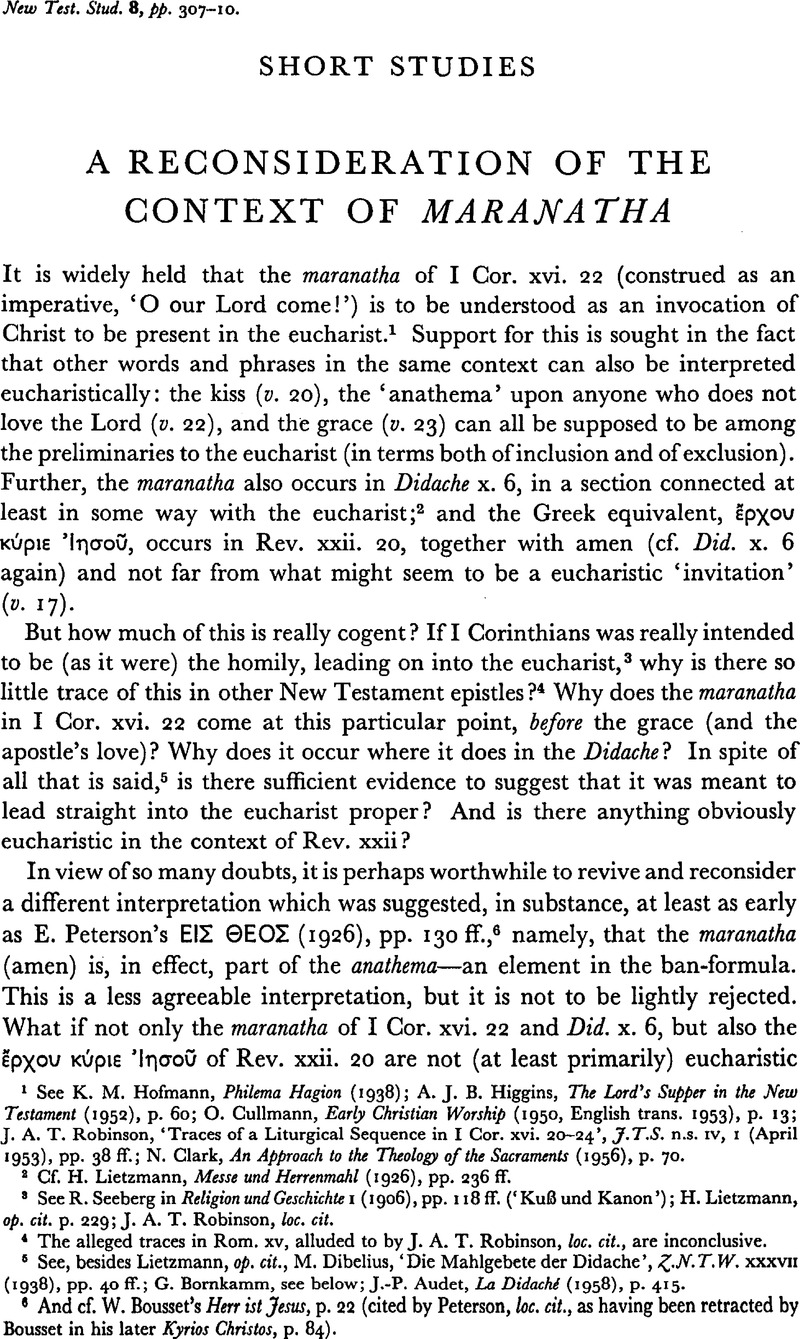No CrossRef data available.
Published online by Cambridge University Press: 05 February 2009

page 307 note 1 see Hofmann, K. M., Philema Hagion (1938); A. J. B. Higgins, The Lord's Supper in the New Testament (1952), p. 60; O. Cullmann, Early Christian Worship (1950, English trans. 1953), p. 13; J. A. T. Robinson, ‘Traces of a Liturgical Sequence in I Cor. xvi. 20–24’, J.T.S. n.s. IV, I (April 1953), pp. 38 ff.; N. Clark, An Approach to the Theology of the Sacraments (1956), p. 70.Google Scholar
page 307 note 2 Cf. Lietzmann, H., Messe und Herrenmahl (1926), pp. 236 ff.Google Scholar
page 307 note 3 See Seeberg, R. in Religion und Geschichte I (1906), pp. 118 ff. (‘Kuβ und Kanon’); H. Lietzmann, op. Cit. p. 229; J. A. T. Robinson, loc. cit.Google Scholar
page 307 note 4 The alleged traces in Rom. xv, alluded to by J. A. T. Robinson, loc. cit., are inconclusive.
page 307 note 5 See, besides Lietzmann, op. cit., M. Dibelius, ‘Die Mahlgebete der Didache’, Z.N.T.W. xxxvii (1938), pp. 40 ff.; G. Bornkamm, see below; J.P. Audet, La Didaché (1958), p. 415.
page 307 note 6 And cf. W. Bousset's Herr ist Jesus, p. 22 (cited by Peterson, loc. cit., as having been retracted by Bousset in his later Kyrios Christos, p. 84).
page 308 note 1 S.-B. in loc. (III, p.494) allude to the ingenious suggestion (whose?) that maranatha is an interpretation of anathema along the lines of analysing the rabbinic word ![]() (‘ban’) as
(‘ban’) as ![]() ‘the Name [of Yaweh] comes’. But they note that this cannot be substantiated from rabbinic writings.
‘the Name [of Yaweh] comes’. But they note that this cannot be substantiated from rabbinic writings.
page 308 note 2 Zur Einführung in das Wörterbuch zum N.Y. (Coniectanea Neotestamentica, xv (1955)), p. 26 (printed as the introduction to Arndt and Gingrich's version of Bauer).Google Scholar
page 308 note 3 It is perhaps significant that Peterson, op. cit.p. 233 (in a different context) is able to cite, from a Coptic amulet, an amen and a ταχú ταχú in juxtaposition.
page 309 note 1 In T.W.N.T. iv, pp. 470 ff.Google Scholar
page 309 note 2 ‘Das Anathema in der urchristlichen Abendmahlsliturgie’, Theol. Literaturz. LXXV (1950), 4/5, pp. 227 ff., reprinted (in a revised form) in Das Ende des Gesetzes (1952), pp. 123 ff.Google Scholar